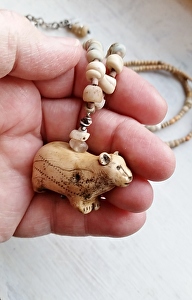This article by Luann Udell originally appeared on Fine Art Views, an art marketing blog hosted by Fine Art Studios Online.
DOES STORYTELLING WORK?
Yes. Yes, it does.
For years now, I’ve advocated for creative people telling their stories. I believe the “why” of what we do is far more powerful than just the “how”.
I also know that some artists have fought long and hard for their credentials—their education, the shows they’ve been juried into, the awards they’ve won. Anything else seems, well, unprofessional. Perhaps even fluffy.
I get it. I do. When I first started my art career, I methodically entered all kinds of juried exhibits. I’m proud of the awards I’ve won. I’m especially delighted when my professional peers—other artists, galleries, etc.—sing my praises. After all, they see a lot of work. When they choose mine for their own homes, it’s a major thumbs-up for me.
I also know how extremely uncomfortable some people feel about sharing what’s in their heart and soul. They feel safe sticking to the tried-and-true. What they do is working for them, so I won’t ask them to change that.
And yet…..
I spent a weekend at a state-wide storytelling workshop, a collaboration between our Sonoma County Library, Creative Sonoma (of the Sonoma County Economic Development Board), the California State Library and StoryCenter.org. The project’s goal was to gather 100 stories that represent the ‘voices’ of California.
You can read more at http://www.storycenter.org/.
Ten people from Sonoma County were selected to share their stories, which would be transformed into ‘digital stories’—recorded in our own voices, with images, and music—no more than two or three minutes in length.
As a matter of full disclosure, I was NOT one of the original ten people selected. Someone else dropped out, and I was offered their place.
Also, when we first told our stories to the group, I said I had no trouble telling stories. Keeping it to 300 words? Almost impossible.
Two huge things happened during the class.
First, I was overwhelmed with technical difficulties. My laptop crashed, my internet connection wouldn’t take, I had trouble working with the video production software (WeVideo.com). I was the absolute last person to create a video, and it’s really not even finished yet. (I’ll be putting the last details on it in the upcoming week—I hope!) That was hard. There’s a steep learning curve to any video editing process, my husband reassures me, and at least I’ve discovered SoundCloud and CreativeCommons.com, social sharing sites for images and music. A challenge, but it’s good to challenge ourselves.
The second thing is wonderful. I was astonished and amazed by the stories people brought to share.
Every single person had a story. Each was very different from the other (although most people were involved in the creative arts.) Some were funny, some were hard. Some weren’t resolved yet. Some had no ‘answer’. But each one was intriguing.
And these are only our first stories. I realized there will be many more to come.
Here was another powerful aspect of these stories:
I remembered everyone’s name in the class, something that’s usually problematic for me.
I remembered everyone’s story.
And everyone’s story was powerful beyond words.
Not all the stories sounded like winners during our first ‘sharing’. This was probably due to the fact that some folks hadn’t actually shared them before. They rambled, they had trouble finding the ‘point’. Some stories were so new, people were was still working through them.
But in the composition and editing process (and our teachers’ experience guiding us), we learned to find the ‘hooks’. We were strongly encouraged to not tell several stories at once, something I struggle with. (Hence, my 1,000-word articles!) We found our strong beginnings, and our thoughtful endings.
Images were powerful. Music helped connect.
And our voices? Oh, our voices…..
We each created a ‘script’ of our stories, and read and recorded them.
And every single one of us nailed it on the first reading.
One instructor marveled at this. “Even the people who insisted on a second take? Their first version was better!” she said. “And everyone read it with such power…it’s astonishing!”
At the end of the class, we watched the (mostly) finished videos. Each one was a winner.
You don’t have to rush out and create a video (although I’m definitely going to explore this further.) You don’t have to have a full-media story telling experience to connect with an audience. Although I hope it’s not lost on you that, as artists, we already have our visuals. In fact, I used images of my artwork, as my story was about how I became an artist in mid-life.)
I do hope you’ll consider telling your story to your audience.
A thousand people here in Northern California paint the ocean, the vineyards, the rolling hills. Every artist captures the light, a moment in time, or a glimpse of something hidden. Many are beautiful, and most are at least competent.
And yes, there are people who, unsure of their decision, will be reassured you are as good as you say you are, by reading your list of accomplishments and awards, or checking the well-known galleries that carry your work..
But a good story, a story that connects your experience to those of your customers, will make you stand out from the crowd.
Create that powerful connection. Make your mark.
Be unforgettable.







